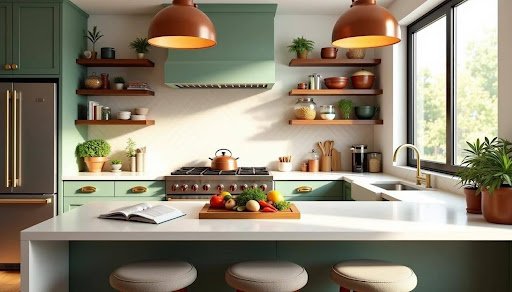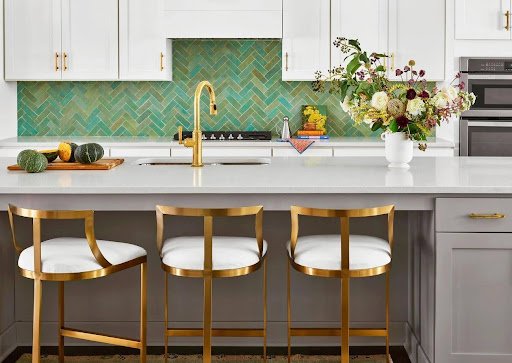
A kitchen serves as the heart of any home. People make meals, share memories and engage in conversations here. Many homeowners want to create spaces that reflect their personality while staying functional, whether they plan a complete renovation or just want to refresh their existing kitchen.
Kitchen planning requires a balance between enduring principles and current trends. The time-tested “kitchen triangle” concept still forms the foundation of smart design by connecting the sink, stove, and refrigerator. New ideas like “dopamine décor” encourage us to fill our spaces with colors and items that bring us joy. Homeowners can find inspiration from design photos, galleries and modern kitchen concepts that will stay relevant through 2025 and beyond.
Designing for Function and Flow
A well-designed kitchen needs careful planning that balances efficiency with comfort. Kitchens differ from other rooms because they need a perfect mix of workflow and personal style. Let’s look at ways to design a kitchen that’s both functional and beautiful.
Optimizing the kitchen triangle layout
The kitchen triangle concept remains the life-blood of good design since its introduction in the 1940s. This principle links three vital work areas—the sink, stove, and refrigerator—to create a smooth cooking experience. Each side of the triangle should measure between 4 and 9 feet, with the total perimeter between 13 and 26 feet. No cabinets or obstacles should cut across any leg of the triangle by more than 12 inches.
Your movement through the kitchen matters beyond the simple triangle. Dedicated zones for prepping, cooking, cleaning, and storing will improve your workflow. To cite an instance, place your prep zone near the sink to wash ingredients easily, then put your cooking zone close by for quick transfers.
Smart storage solutions for daily ease
Even small kitchens become highly functional spaces with smart storage. Vertical space offers great potential—unused areas above refrigerators and cabinets hide storage opportunities.
These proven solutions make daily tasks easier:
- Pull-out shelves and drawers eliminate awkward bending into cabinets
- Drawer dividers bring order to chaotic tool collections
- Expandable risers maximize cabinet space by creating additional levels
- Under-cabinet hooks keep frequently used items within easy reach
Note that ergonomics plays a vital role in storage placement. Items you use daily should sit between shoulder and knee height to reduce strain. Occasional-use items can go in higher or lower spaces.
Adding Personality Through Color and Texture

Image Source: Better Homes & Gardens
A well-laid-out kitchen needs more than just functionality—it should be a reflection of who we are. Colors and textures reshape the scene, turning an efficient space into one that brings joy and sparks creativity.
Choosing cabinet colors that reflect your style
Cabinet colors create the emotional atmosphere of your kitchen. The 2025 trends show a shift toward colors that bring comfort and stability. Bold statements come from dark and moody tones like rich browns, deep reds, and even black, which radiate sophistication. Greens and blues remain prominent choices, ranging from serene sage to deep forest green, and they connect us to nature.
These trending options might catch your eye if you want something different:
- Soft pinks with gray and white accents add warmth
- Warm neutrals like cashmere and mushroom give a softer feel than gray
- Two-tone cabinets create visual interest—picture scarlet red with dune black
The finish adds personality to your kitchen. Matte textures create a relaxed atmosphere while glossy surfaces bring a dramatic touch. You can draw inspiration from art and design, and the soft tones of a pink painting can remind you how color and texture work together to create warmth and harmony.
Using décor to tell your story
Texture adds the final layer to your kitchen’s character. Mix different materials—wood, stone, metal, and fabric—to create visual interest without cluttering the space. Natural elements like wood and stone add warmth and authenticity, especially alongside handcrafted pieces.
Show off cookbooks that inspire you and ingredients that make you happy. Open shelving displays beautiful dishware and adds visual depth. The beauty of texture lets your kitchen tell a story that feels genuine, personal, and alive. For a creative and personal touch that reflects your style and memories, you can see a full collection of custom paint‑by‑numbers kits that lets you turn favorite photos into your own artwork, adding a unique and meaningful accent to your kitchen décor.
Creating a Space That Inspires Creativity
A truly exceptional kitchen does more than look good and work well – it fires up your culinary imagination. Smart layouts and eye-catching displays can turn everyday cooking into creative adventures.
Setting up zones for cooking, prep, and inspiration
The best modern kitchens go beyond the traditional triangle. They need purpose-driven zones. Your kitchen should have specific areas to prepare, cook, and clean. This creates a workflow that boosts culinary creativity. Keep your prep zone free of clutter with plenty of counter space near cooking and food storage areas. You might want to create an inspiration zone – a coffee station with your favorite beans and equipment or a cozy reading nook to browse recipes.
Displaying cookbooks and tools that spark ideas
Cookbooks should be seen, not hidden away. They bring warmth and character to your kitchen while keeping inspiration close at hand. You can store them many ways – from rustic countertop boxes for cookie recipes to picture frame ledges that show off beautiful cover art. Books arranged by color make a stunning statement, or group them by cuisine type so they’re easy to find. Put a cookbook holder near your prep zone for the day’s chosen recipe. Cabinet-top storage serves double duty – save room for family photos or travel mementos that might inspire your next dish.
Using open shelving to showcase ingredients
Open shelves turn simple ingredients into décor while keeping them easy to reach. Glass containers make dry goods look artistic and stay fresh longer. Small kitchens feel more spacious with this approach. Items look best when arranged with care – stack cups and bowls in gentle curves rather than straight lines. Add baskets and decorative jars to create texture while staying organized. Open shelving works magic by blending beauty with function, making everyday ingredients spark inspiration.
Encouraging Joyful Gatherings and Togetherness
The best kitchens are more than cooking spaces – they’re places where families share stories and friendships grow stronger. A well-designed kitchen reshapes the scene from solo cooking to shared moments that build lasting bonds.
Adding seating for casual conversations
The right kitchen seating makes people want to stay, talk and be part of meal preparation. Your island seating needs 24 to 30 inches of counter width per person to give everyone enough elbow room. Your kitchen layout might work well with these options:
- One-sided seating lets people chat with the cook or grab quick bites
- Two-sided seating brings people face-to-face
- Three-sided seating creates a table feel that sparks closer talks
Seats with good back support and cushioning help guests stay comfortable, which matters a lot during longer gatherings. Built-in banquette seating has become popular as it creates a more relaxed atmosphere for get-togethers.
Using lighting and layout to invite connection
The right lights can make a big difference in how people interact. Your kitchen needs layers of light:
- Task lights for cooking areas
- Overall room lighting
- Pendant fixtures above islands and dining spots to mark social areas
Dimmer switches are a must – they help switch the mood from bright cooking space to cozy gathering spot. Good lighting boosts the atmosphere and reduces stress at social events.
A smart layout lets people move easily between cooking and socializing areas. Separate zones for prep work and gathering prevent crowding but keep conversations flowing naturally between spaces.
Conclusion
A kitchen is more than a place to cook—it should inspire creativity and bring people together. Balance function and personal style with smart layouts, storage, and thoughtful color choices. Displaying cookbooks, ingredients, and textures adds personality, while comfortable seating and layered lighting encourage shared moments. A well-designed kitchen reflects who you are, making everyday meals enjoyable and memorable.